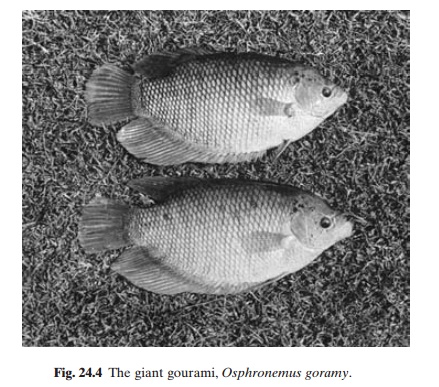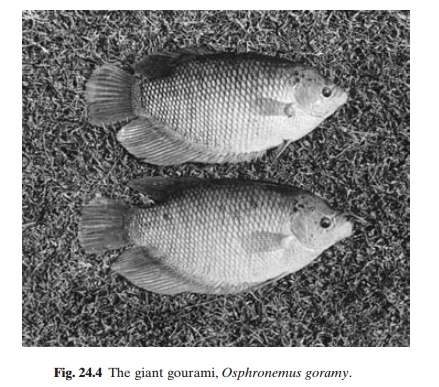Chapter: Aquaculture Principles and Practices: Other Finfishes
Gouramis

Gouramis
Though the overall aquaculture production of the species generally
referred to as gouramis (belonging to the family Anabantidae) is not very high,
they have nevertheless been important in traditional farming practices in the
Southeast Asian countries and continue to be so. Compared to other aquaculture
species, the gouramis have not attracted much attention from scientists so far
and the culture practices have not undergone any major changes in the recent
past.
The three species known as gouramis are the giant gourami, Osphronemus goramy (fig. 24.4), the
Siamese gourami or sepat siam, Tri-chogaster
pectoralis, and the kissing gourami, Helostoma
temmincki. Though they were allconsidered as belonging to the same family
Anabantidae, in later classifications the first two species are placed in a new
family Osphronemidae and the third in Helostomidae.
All are tropical species which can live in swampy conditions and breathe
atmospheric oxygen through accessory respiratory organs. They spawn easily
under pond conditions and are well relished by consumers. They can be described
as omnivorous, with plankton and various types of plant matter dominating the
diet. Probably because of the slow growth rate, as in the giant gourami, or the
relatively smaller size attained by the others, the earlier wide-spread
interest in culturing gouramis appears to have diminished somewhat and is now
restricted to small-scale extensive farming in some of the Southeast Asian
countries.
The giant gourami is the most highly-priced species and has been
introduced into a number of countries in the Indo-Pacific region. It can be
grown in fresh and slightly brackish water, but is sensitive to temperatures
below 15°C. The optimum temperature is 24–28°C. It is reported to reach a
length of 61 cm and a weight of 9 kg.

Young of the species feed on planktonic organisms, but the adults show a preference for aquatic vegetation.
The Siamese gourami attains a maximum length of about 25 cm and is
raised in some areas as a rotational crop in rice fields. It is usually
marketed as a dried product, which is highly esteemed in countries like
Thailand.
The kissing gourami, which derives its name from its characteristic
labial contacts (sugges-tive of kissing) is a fresh-water fish that is
predominantly a plankton feeder, but it will feed on most artificial fish
feeds. It reaches a maximum length of 30 cm and spawns every three months.
The culture systems adopted for the gouramis are generally extensive,
and often in polyculture with other species.
Related Topics